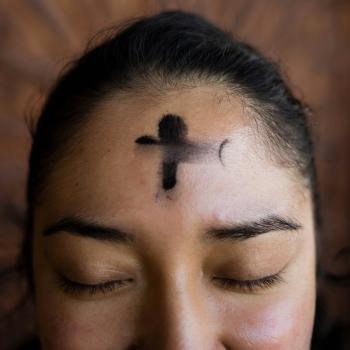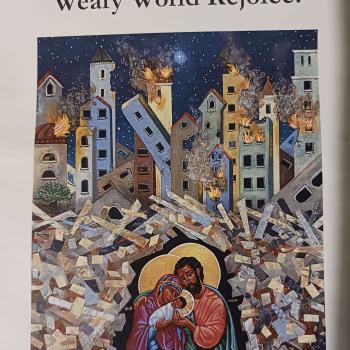“Words are very unnecessary / They can only do harm
Enjoy the silence”
(Depeche Mode)
German political theologian Fr. Johann Baptist Metz famously wrote on many occasions that the challenge for theologians in the second half of the twentieth century would be to learn how to write theology that places the world’s victims at the center of its reflection. In particular, Metz insisted that theologians could no longer do their work with their backs turned to Auschwitz. In his most recent book, Catholic theologian Tom Beaudoin echoes Metz, writing that today we cannot do theology with our backs turned to the victims of sexually abusive priests. (His reflections on the latest round of abuse reports can be seen here or here.)
But this is, I fear, precisely what is likely to happen in most Roman Catholic parishes during Holy Week. Given the tendency toward apolitical and irrelevant homilies that have become standard in our communities, I have my doubts that many Good Friday homilies will make reference to the crucifixions experienced by victims of sexually abusive clergy. A friend of mine, and a doctoral student in theology herself, remarked to me that the Pope’s silence in the face of cover-up accusations could be due to the view that Holy Week is perhaps not an appropriate time to discuss such things. I suggested in return that if in Holy Week we focus our attention on the suffering of Christ, then acknowledging the Christ that suffers in the victims seems entirely fitting this week. More than fitting. Necessary. But sadly, if we are to get any reference to the scandal at all, it is likely to be the sort of thing Archbishop Timothy Dolan’s flock received at Mass this past Passion/Palm Sunday when he insisted that it is Pope Benedict who has been “crucified”.
In such a context of silence, denial, defensiveness, and submissiveness, what would a Triduum celebration even mean if not the willful liturgical obscuring of the continued crucifixion of Christ today? The Catholic mystical tradition has consistently insisted that Christ suffers today in his body. But as Salvadoran liberation theologian Jon Sobrino presses us, “it would be idle to say that Christ crucified has a body in history and not identify it in some way. […] From the viewpoint of christology we must ask what this body is.”
It is truly difficult to hear the continued reports of children raped by priests and not be struck by the presence of the Crucified One there. But this presence is denied — “I do not know the man!” — each and every time church leaders and members alike remain silent or utter words of defensiveness that embarrassingly fill nearly every news story or ecclesial statement covering the abuse.
Is a Triduum that intentionally turns its back on the suffering body of Christ in such a way worth celebrating? No doubt, we will hear once again the church’s language of “entering into the sufferings of Christ” as we do each and every year. But when will we learn that such pieties are at best meaningless or at worst utterly destructive if we are unwilling as a church to identify — and to identify with — Christ’s suffering body today? We cannot enter into Christ’s sufferings without entering those of his body. Indeed, the only way to enter into Christ’s sufferings is through the sufferings of others.
If we do not — if we cannot — do so, if we cannot, as Paul said, “discern the body” and we instead celebrate the holy mysteries without a recognition of the victims, we eat and drink condemnation on ourselves.
Archbishop Oscar Romero was conscious of the way the “crucified peoples” mediate the presence of the Crucified One. Despite his position of privilege, Romero saw the crucified people around him yet did not deny their presence, cover them up, or become defensive about the political and religious systems that produced them. Instead, he “incarnated” himself among the crucified and shone a light onto them insisting that they were the ones God loves the most. And he did this no matter how uncomfortable it would be and with no regard for the repercussions. We know the end of that story.
Despite Romero’s relevance as a true model for today’s episcopacy and today’s church, I fear that Romero too will be absent and unremembered over the course of this week’s liturgies. Although his life, death, and resurrection among his people mediates to us something of the Christ event, our backs, and the backs of our celebrants and homilists, will be turned to him as well.
Liturgy should always, though usually does not, draw us into the sufferings of others. During Holy Week, the celebration of the Lord’s passion and resurrection, this should be even more true. But as a life-long faithful participant in the church’s liturgical life, I am increasing frustrated by the fact that we literally have to work against the liturgy — as it is conducted by most celebrants and most communities anyway — in order for this to happen. The suffering of human persons at the hands of our social, political, and ecclesial systems is “disappeared,” removed even from our liturgies where our anamnetic words and actions suffer from the worst kind of spiritual myopia and, as Sobrino calls it, “christological deism.”
And from where I stand, just days away from these holiest of days, I anticipate only more silence in the face of the reality of the world’s suffering, especially that suffering directly caused by the church. And I am not sure I can take it this year.












